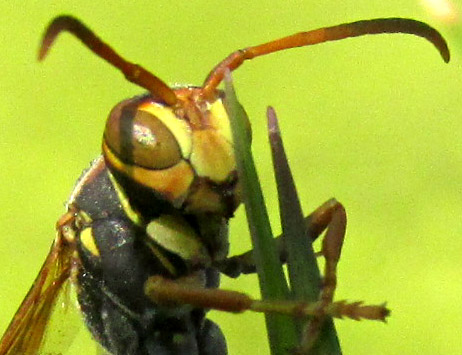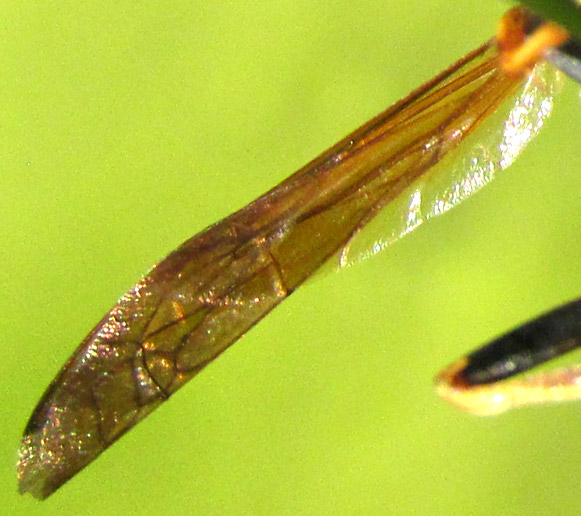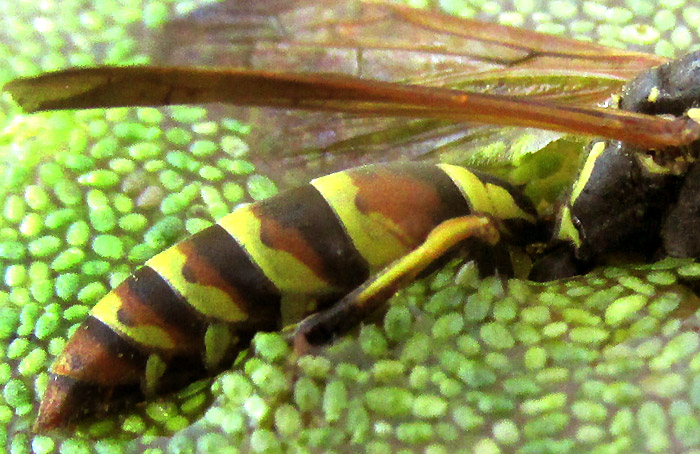Excerpts from Jim Conrad's
Naturalist Newsletter
Entry dated August 10, 2023, issued from near Tequisquiapan, elevation about 1,900m (6200 ft), Querétaro state, MÉXICO
(~N20.57°, ~W99.89°)
HUNTER'S LITTLE PAPER WASP

Atop a spike of emerging grass-blades on the banks of a little pond, the above unusually small wasp perched for several minutes before I went to see what she was doing. This region is suffering a long, hard drought and the landscape is parched and dusty, but at 9:30AM the grass at the pond's edge was wet with dew, while a few feet away everything was dry. Maybe the wasp had been gathering dew. It can be hard to identify wasps because many kinds are recognized, mostly yellow and black like this one, and Mexican wasp species aren't well known, but this wasp was letting me get close, so I decided to give it a try.
Fortunately, the US's CDC -- the Centers for Disease Control and Prevention -- currently provides online an excellent pdf document by Harold Scott and Chester Stajanovich entitled "Stinging Hymenoptera: Pictorial Key to Some Common United States Families." Our little wasp looked like a stinging hymenoptera (ants, bees, wasps and sawflies), so I started the ID process with this key, which provides excellent drawings to illustrate its concepts.

An Important field mark the key focused on, and seen in the above picture, is that the part of the back immediately behind the head, the pronotum -- which is black on our wasp -- extends all the way to the base of the wing. That directs us to the superfamily of the yellowjackets, hornets, paper wasps and other wasp kinds, the Vespoidea, thus excluding sphecid wasps such as mud daubers and thread-waisted wasps. Further, our wasp had rested a lot of the time with its wings folded over her back, so that brought us to the family Vespidae, which more narrowly focuses us on the yellowjackets, hornets and paper wasps. Yet another feature important to note is that the suture running from the compound eye's bottom to the "mouth's" dark mandible is fairly long; in wasp-anatomy terms, it crosses a long oculo-malar space. In certain wasp types, that suture hardly exists, with the eye almost touching the mandible.
Better seen in the top picture than the above, the back legs' second large segment, the middle tibia (which is black at the base and expanded like the head of a club) bears two sharp spurs, not one. That feature diverts us from yet more obscure wasp types. In the above picture, the flat, polygonal, yellow part "in the face's middle" below the antenna bases -- the clypeus -- is somewhat pointed downward at its base, not straight across or indented. That feature alone discards the hornets and yellowjackets, bringing us to the subfamily Polistinae, the paper wasps.

So now we know that when our wasp returns home, home won't be a burrow in the ground or dried-mud chambers stuck on a wall someplace, but a paper nest looking like a dried honeybee comb attached to something by a short, slender stalk in the back. However, to find the genus and species, it's still necessary to check such details as displayed in the wing venation seen above. Two transparent wings appear there folded together, so it may take an effort to see the shapes of individual cells formed by the vein network. However, one detail clearly seen is that the wing nearest us does not gradually diminish in width, but instead enlarges in a kind of lobe next to the body. That's the anal lobe, and wings of hornets and yellowjackets don't have them.
My jockeying for a view of the wasp's back scared the creature into flying directly down into the little pond's water, which was carpeted with Brazilian Watermeal. Before replacing the wasp back into the grass, this picture was made, providing a closer view of the head and thorax:

And here's the poor wasp's abdomen displaying distinctive patterns and colors:

At this point our wonderful stinging Hymenoptera pictorial key lands us amid several paper wasp species common in the US but not similar in appearance to our pond wasp. If nothing else, our wasp is very much smaller than they. However, all the key's remaining species are members of the genus Polistes, sometimes known as the umbrella paper wasps. Polistes is a big genus embracing over 300 species worldwide, so a good guess is that we have a Polistes. On the GBIF Polistes occurrences page I zoomed in on central Mexico to see which species have been recorded here. Of the several listed, only one appeared to match our pond wasp, and that was POLISTES DORSALIS, sometimes called Hunter's Little Paper Wasp. The Hunter's part reflects the species' earlier being named Polistes hunteri; the "Little" is because that relative to other Polistes species this one is very much smaller than usual.
Polistes dorsalis occurs all across the southern half of the US, south through all of Mexico to about Nicaragua, possibly farther into South America. Five subspecies are recognized, of which ours appears to be neotropicus, occurring from about here and Veracruz, Mexico to Costa Rica.
Wikipedia provides an extensive Polistes dorsalis page detailing features of our wasp's life history. There we learn that its paper nests often are built in rock piles, hollowed-out logs and other shelters close to the ground. The species' social structure is more flexible than among many social insects, sometimes with biting and "falling fights" -- where both wasps fall from the nest while fighting -- determining dominance and the roles individuals fulfill on the nest. Also, it appears that the closer related individuals are, the more likely they are to show altruistic behavior to one another. The sting of Polistes dorsaslis is described as moderately painful to humans. Our pond wasp wasn't antagonistic at all, rather acting somewhat lethargic, and when it flew, it dove straight into the water, shattering all stinging-wasp stereotypes.
The above Wikipedia page is very informative about Polistes dorsalis, but fails to say much about general features of its life cycle such as what its prey is (lots of caterpillars). Such general life cycle information for paper wasps can be found on Wikipidia's Polistes page.